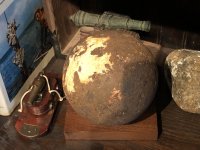digi-shots
Jr. Member
I’m fairly sure this might have been mentioned in previous threads but when you need to flush out salt or mineral deposits one of the easiest ways is something everyone has in their house…
Their toilet tank.. yep, I recovered a cannonball many years ago from salt water and after treating with reverse electrolysis I soaked the cannonball in the toilet tank for quite a few months. With every “flush”of the toilet, fresh water is introduced and your object is continuously ”flushed”. Just don’t forget about it if you should move!
Their toilet tank.. yep, I recovered a cannonball many years ago from salt water and after treating with reverse electrolysis I soaked the cannonball in the toilet tank for quite a few months. With every “flush”of the toilet, fresh water is introduced and your object is continuously ”flushed”. Just don’t forget about it if you should move!





